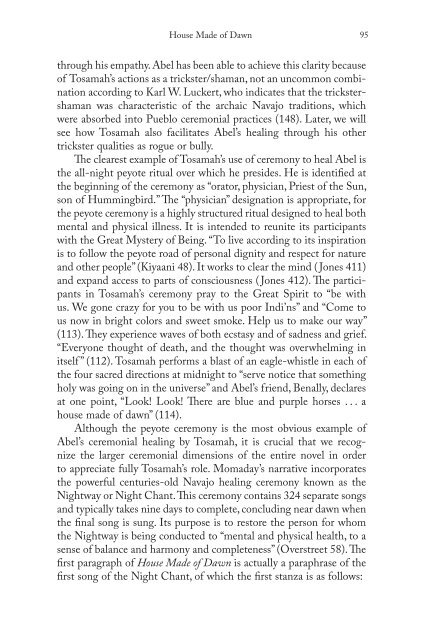Blooms Literary Themes - THE TRICKSTER.pdf - ymerleksi - home
Blooms Literary Themes - THE TRICKSTER.pdf - ymerleksi - home
Blooms Literary Themes - THE TRICKSTER.pdf - ymerleksi - home
Create successful ePaper yourself
Turn your PDF publications into a flip-book with our unique Google optimized e-Paper software.
House Made of Dawn 95<br />
through his empathy. Abel has been able to achieve this clarity because<br />
of Tosamah’s actions as a trickster/shaman, not an uncommon combination<br />
according to Karl W. Luckert, who indicates that the trickstershaman<br />
was characteristic of the archaic Navajo traditions, which<br />
were absorbed into Pueblo ceremonial practices (148). Later, we will<br />
see how Tosamah also facilitates Abel’s healing through his other<br />
trickster qualities as rogue or bully.<br />
Th e clearest example of Tosamah’s use of ceremony to heal Abel is<br />
the all-night peyote ritual over which he presides. He is identifi ed at<br />
the beginning of the ceremony as “orator, physician, Priest of the Sun,<br />
son of Hummingbird.” Th e “physician” designation is appropriate, for<br />
the peyote ceremony is a highly structured ritual designed to heal both<br />
mental and physical illness. It is intended to reunite its participants<br />
with the Great Mystery of Being. “To live according to its inspiration<br />
is to follow the peyote road of personal dignity and respect for nature<br />
and other people” (Kiyaani 48). It works to clear the mind ( Jones 411)<br />
and expand access to parts of consciousness ( Jones 412). Th e participants<br />
in Tosamah’s ceremony pray to the Great Spirit to “be with<br />
us. We gone crazy for you to be with us poor Indi’ns” and “Come to<br />
us now in bright colors and sweet smoke. Help us to make our way”<br />
(113). Th ey experience waves of both ecstasy and of sadness and grief.<br />
“Everyone thought of death, and the thought was overwhelming in<br />
itself ” (112). Tosamah performs a blast of an eagle-whistle in each of<br />
the four sacred directions at midnight to “serve notice that something<br />
holy was going on in the universe” and Abel’s friend, Benally, declares<br />
at one point, “Look! Look! Th ere are blue and purple horses . . . a<br />
house made of dawn” (114).<br />
Although the peyote ceremony is the most obvious example of<br />
Abel’s ceremonial healing by Tosamah, it is crucial that we recognize<br />
the larger ceremonial dimensions of the entire novel in order<br />
to appreciate fully Tosamah’s role. Momaday’s narrative incorporates<br />
the powerful centuries-old Navajo healing ceremony known as the<br />
Nightway or Night Chant. Th is ceremony contains 324 separate songs<br />
and typically takes nine days to complete, concluding near dawn when<br />
the fi nal song is sung. Its purpose is to restore the person for whom<br />
the Nightway is being conducted to “mental and physical health, to a<br />
sense of balance and harmony and completeness” (Overstreet 58). Th e<br />
fi rst paragraph of House Made of Dawn is actually a paraphrase of the<br />
fi rst song of the Night Chant, of which the fi rst stanza is as follows:

















